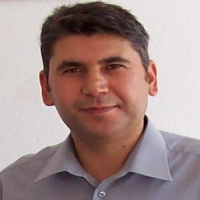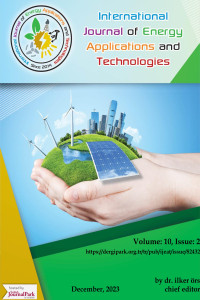Research Article
Review Article
Issue Editorial Board


Aksaray Üniversitesi, Makine Mühendisliği Bölümü
Isı transferi, Nanaoakışkanlar, CFD, Salınımlı akışlar, Sınır tabaka
Aim & Scope
International Journal of Energy Applications and Technologies (which publishes blind peer reviewed original research articles) is aimed
at presented a chance to students, researchers, research scholars, teachers,
authors and other professionals in the field of research in energy technologies
subjects, to publish their original and current research worldwide,
international community. The journal aims to be a leading peer-reviewed
platform and an authoritative source of information for analyses, reviews and
evaluations related to energy.
The breadth of coverage ranges from innovative technologies and systems
of both fossil and renewable energy to the economic industrial and domestic use
of energy with no or minor impact on the environment. The journal covers
research in mechanical engineering and thermal sciences, with a strong focus on
energy analysis, energy modelling and prediction, integrated energy systems,
energy planning and energy management, energy conservation, energy efficiency,
biomass and bioenergy, renewable energy, electricity supply and demand, energy
storage, energy in buildings, conservation strategies, and the environmental,
social and economic impacts of energy policies and usage, including climate
change mitigation and other environmental pollution reduction and on economic
and policy issues, provided such topics are within the context of the broader multi-disciplinary
scope of Energy.
Author Guidelines
Please, firstly you must register to Turkish Journal Park system. You can submit your article via your user page at https://dergipark.org.tr/ijeat
YOU CAN ACHIEVE TO EXAMPLE MANUSCRIPT TEMPLATE.
You must be prepared your manuscript according to rules below.
* The title of article must be 14 point.
* The under of article title must be contain author(s) name(s) and complete affiliation(s), title, and complete mailing address of the person to whom all correspondence should be addressed. Besides, author(s) must give their ORCID number before abstract section.
* Abstract must be, and it must be occurred from between 150-250 word.
* Maximum 5 keywords must be. (upper case at the beginning of each keyword, semicolon between keywords, and keywords must be in alphabetical order)
*Abstract and Manuscripts should be double-spaced using 12-point font in Times New Roman.
* The manuscript must be prepared as single column.
* Main sections and subsections should be numbered consecutively.
* All of the references given at the end of the paper that listed consecutively should be cited in the main text with numerals in a square bracket, for example [1, 2-5].
* Contents of tables should be 12-point font. If necessary, these can be lower point font.
* Figures must have at least 300 dpi resolution. Black and white or colored figures are acceptable.
* Each table and figure should be cited in the text.
* Equations must not be images or pictures. They must be prepared in office word equation editor.
* Nomenclature and abbreviations can present as a table.
Authorship contribution statement for Contributor Roles Taxonomy
Contributor Roles Taxonomy was introduced with the intention of recognizing individual author contributions, reducing authorship disputes and facilitating collaboration. The corresponding author is responsible for ensuring that the descriptions are accurate and agreed by all authors. For example;
İlker Örs: Writing - original draft, Investigation, Visualization, Supervision, Conceptualization, Methodology, Software, Formal analysis. Murat Ciniviz: Investigation, Supervision, Writing – review & editing. Savaş Yelbey: Investigation, Visualization, Supervision. Bahar Sayın Kul: Conceptualization, Methodology, Software, Formal analysis.
Conflict of interest
The author(s) declares that he has no conflict of interest.
References
References must show in text as single reference [1], multi reference [1, 4, 8, 10], if references are consecutive [1-5], it is expressing 1, 2, 3, 4, and 5 number references. References must be numbered according to the order of use in the manuscript. References must be size 12pt. All references must show with its original language.
Reference to a journal publication:
Last name, Initial. Publishing year. Publishing name. Journal Name, Volume(Issue), pages.
Örs, İ., Ciniviz, M. and Sayın, B. 2016. Using of biofuel – diesel fuel blends in a diesel engine. Internal Journal of Energy Applications and Technologies, 4(1), 223-234.
Örs, İ. and Ciniviz, M. 2019. Renewable energy systems in Turkey. Internal Journal of Energy Applications and Technologies, 4(1), 223-234.
Örs, İ. 2018. The production of biodiesel from safflower seed oil. Internal Journal of Energy Applications and Technologies, 4(1), 223-234.
Reference to a book:
Last name, Initial. Book name, Edition number, Publisher, Place Published, Year.
Ors, I., Ciniviz, M. and Sayın, B. Using of biofuel – diesel fuel blends in a diesel engine, Fourth edition, AcademicPaper, Turkey, 2000.
Reference to a chapter in an edited book:
Last name, Initial. (Section author(s)), Section name, in: Editor(s)/Author(s) of book, Book Name, Edition number, Publisher, Place Published, Year, pages.
Ors, I., Ciniviz, M. and Sayın, B. Diesel engines, in: Kahraman, A., Oguz, H., Internal Combustion Engines, Second edition, AcademicPaper, Turkey, 2000, 158-172.
Reference to a Master or Ph.D. thesis:
Last name, Initial. Year. “Thesis name”. Master/Ph.D. thesis, University/Institute/Faculty, City, Country, pages.
Ors, I. 2000. “Using of biofuel – diesel fuel blends in a diesel engine”. Ph.D. thesis, Selcuk University, Graduate School of Natural Sciences, Konya, Turkey, 66-95.
Reference to a conference presentation (at conference book):
Last name, Initial. Publishing year. Presentation name. Organization/Conference/Symposium Name, Organization dates, Volume(Issue), City, Country, pages.
[1] Ors, I., Ciniviz, M. and Sayın, B. 2016. Using of biofuel – diesel fuel blends in a diesel engine. International Conference on Advanced Technology & Sciences, 23-25 November, 4(1), Rome, Italy, 223-234.
Reference to a web page/site:
Author, Title, Year|. URL. (Accessed Access Date Access Year).
[1] Örs, İ., The article, 2016. https://dergipark.org.tr/ijeat/issue/27866/294888 .(18 March 2020.)
YOU CAN ACHIEVE TO EXAMPLE MANUSCRIPT TEMPLATE.
After acceptance the Journal will publish articles quickly online FREE OF CHARGE.
Ethical Principles and Publication Policy
Editorial Responsibilities
The Editor-in-Chief, Managing Editor and International Editorial Board are responsible for deciding which articles submitted to International Journal of Energy Applications and Technologies will be published.
The Editor-in-Chief reserves the right to decide not to publish papers that the journal deems insufficient in terms of content and quality.
The all editorial team of journal must hold no conflict of interest with regard to the articles they consider for publication.
The Editor-in-Chief and other editorial members shall evaluate manuscripts for their intellectual content free from any racial, gender, sexual, religious, ethnic, or political bias.
Author's Responsibilities
The authors ensure that the paper is the original study and that it has not been published in another journal and that the same paper has not been sent to another journal in parallel.
The Authors also warrant that the manuscript is not and will not be published elsewhere (after the publication in International Journal of Energy Applications and Technologies) in any language without the consent of the Editorial Board.
If the submitted paper is the result of a research project, or if it has been presented at a conference before, or if there is any institution or organization that supports the paper, the authors must present this information in the Acknowledgments section.
It is the authors' responsibility to ensure that the submitted paper conforms to ethical standards. Confirming that the information in the manuscript is not unfounded or unlawful and does not violate the rights of third parties, it meets any claims compensation from this situation and the publisher cannot be held legally responsible.
Plagiarism
Presenting another person's ideas, words, sentences or creative expressions as his own is a clear plagiarism in terms of scientific ethics.
It is considered plagiarism to use a specific statement from another author's study in one's own study without clearly citing the source, not citing the source correctly, or using the source without permission. The article of the author determined to be plagiarized will be rejected directly.
Conflict of interest
Authors must explain the people, institutions and organizations that may have conflict of interest.
Reviewers responsibilities
The Reviewers should submit their unbiased opinions in writing on the scientific value and originality of the paper in a timely manner.
The reviewers evaluate the submitted article according to the scope of the journal, the originality of the subject, the presentation of the article, scientific quality and characteristic.
The reviewers should warn the editor when they detect an ethical violation, significant similarity with a manuscript published elsewhere, and such situations.
The Reviewers should not have a conflict of interest with the authors or the institutions or organizations that support the paper. Such a situation should be reported to the editor.
Reviewers must be impartial when evaluating the paper. It should clearly express its opinions, thoughts and criticisms with supporting arguments.
All documents sent to the reviewers for review should be considered confidential. Subject and materials specified in the papers cannot be used without the permission of the authors. If this information is used for personal gain, all responsibility belongs to the user.
Peer review
The all submitted manuscripts are subject to a peer review process in order to Editorial Board in making editorial decisions. Thus, the author may improve and increase quality of paper. also assist the author in improving the paper.
Reviews are single-blind procedure. The least two positive comments should be obtained for acceptance of the paper. Reviewers may suggest also minor or major revision. If major revision is decided by reviewers, the revised paper can be sent again to the reviewers for their final decisions. There are no fees for reviewers.
Reviewers are determined by editor. Editor can also prefer the reviewer’s choice from suggests of authors. Reviewers must be experts in the subject of paper. There should be no conflict of interest between the authors and the referees. The authors will definitely not know the name of reviewers. The editorial board will provide it. Besides, the reviewers also will not know each other's identity. The reviewers will evaluate independently of each other. In case the reviewers make different decisions (accept/decline), the Editor may submit the article to another reviewer for evaluation.
Disclaimer
The views in published works are belongs to authors. The Editors and Editorial Board cannot be held responsible. The authors take legal and moral responsibility for the ideas expressed in the articles. The authors will be held legally responsible should there be any claims for compensation. There is no liability of Publisher.
Withdraw, Retraction and Publication Malpractice Policy
Before or during the evaluation of the article; The article should be withdrawn by the author because of the important changeable errors detected by the authors, the editorial board or the reviewers. For example; double posting of the article by mistake, typographical errors, incomplete data entry and etc.
The following reasons are the reasons why the article is retracted even if the article is ready for publication.
Multiple submissions
Bogus claims of authorship
Plagiarism
Fraudulent use of data etc.
If the article has been published, the reader will see the retraction note of the article electronically via a link before reaching the original article. He then reaches the original article with a watermark that says "RETRACTED" on each page.
After the article is published, it may be necessary to change the article for reasons other than those that require the article to be retracted. In this case, the new version of the article is published in the last issue of the journal. Necessary explanations for the change are specified in this new version and a link is made to the previous version.
Price Policy
After acceptance the Journal will publish articles quickly online FREE OF CHARGE.





